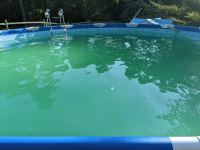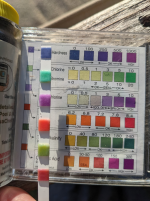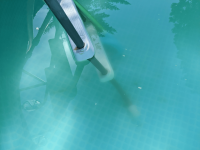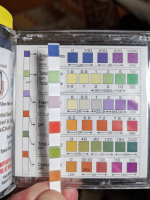We bought a 15' round Intex pool on Craigslist to get us through the early days of COVID. Well, COVID and the pool both lasted longer than expected, and here we are. We used chlorine tablets (the small ones) and DryTec calcium hypochlorite shock the first year and had no trouble at all. We drained it over the winter. Last year, we did the same and only had trouble once after being away for a few weeks. The pool was slightly cloudy when we got back (someone had been adding chemicals but not vacuuming), but it cleared up after a little shock and running the filter constantly. Again, we drained it over the winter. This year, we've been using chlorine tablets (the big ones). The pool had been so clear it almost looked like it was empty. I hadn't shocked it all. Then, we went away for just a few weeks, and all heck broke loose.
There was a partially-dissolved tab in the floating chlorine dispenser when we left, but it was totally gone by the time we got back. I only have AquaChek test strips, and they were showing total and free chlorine at basically zero. The water was cloudy. I put a new tab in and started running the filter 24 hours a day. That was on July 14th. The next day, the levels were still very low, maybe 1 ppm for total and free chlorine. I put in another chlorine puck and kept the filter going. The next day, the numbers were maybe 5 and 3 ppm for total and free. The water wasn't clearing up at all, so then I put in half a pound of the DryTec shock. The numbers were off the charts after that. They didn't really come back down until two days ago when they were reading in the 5/3 to 10/5 ppm range for total/free. By then, the water was getting cloudier and now was kind of green. The surface of the water had small pockets of foam. Just a small one inch patch here and there, but still something that stood out.
I was beginning to think my strips were off. I know they're not super accurate, but I thought maybe they were just wrong, so I took a sample to a pool store and had them test it:
Free Chlorine: 2.5 ppm
Combined Chlorine: 2 ppm
pH: 7.7
Alkalinity: 115 ppm
Hardness: <50 ppm
Cyanuric Acid: 100 ppm
Copper: <0.3 ppm
Iron: <0.15 ppm
Phosphates: 0 ppb
Borate: 0 ppm
LSI: -0.42
They said the hardness is too low, but that it didn't matter for vinyl pools. They said the cyanuric acid is too high. I had put in stabilizer myself, because I thought that's what you're supposed to do, but they said you don't really need it for these pools. They didn't say what to do about it, but the printout they gave me said the only solution is to dilute with fresh water. They recommended just shocking the pool and then maybe an algaecide. I put in another half pound of shock last night. This morning, the pool was definitely green and very cloudy. I could no longer see the bottom. The pictures are from this morning.
Here's what I have on hand:
AquaChek strips
Chlorine tabs
DryTec shock
Pool Mate Algae Destroyer (never used it myself)
Various alkalinity controls, stabilizers, pH risers and fallers, and an algae destroyer
We're in a heat wave, just like everyone else these days. I assume it's not safe to swim in green water. I assume my test strips aren't accurate enough to know whether it's safe to swim after shocking. I assume I won't be able to get more accurate test strips within the next few days. I assume there's a limit to what my little Intex cartridge filter can do to clean up the water. I figure my options are:
1. Mess around with chemicals for a few days or a week or more and have to keep everyone out of the pool
2. Drain it and refill it and let people swim, albeit in freezing cold water
I'm currently doing option 2. Am I wrong? Should I drain it completely or halfway or what? (Well, halfway isn't an option anymore because the pump is going faster than I expected. But draining two thirds is still an option!) I'm worried that I've got something funky growing and that it'll just come back if I do a partial drain. Then again, even if I did drain it completely, I've got nothing to really fully sanitize the empty liner, ladder, etc., so maybe it's silly to worry about getting rid of the funk entirely before refilling. Also, we're in a drought and really aren't supposed to be filling pools. I feel guilty about doing this already. The last picture shows how much is left in the pool and what it looks like. I just brushed the dark spots on the bottom, which I couldn't even see when I first went out this morning.
There was a partially-dissolved tab in the floating chlorine dispenser when we left, but it was totally gone by the time we got back. I only have AquaChek test strips, and they were showing total and free chlorine at basically zero. The water was cloudy. I put a new tab in and started running the filter 24 hours a day. That was on July 14th. The next day, the levels were still very low, maybe 1 ppm for total and free chlorine. I put in another chlorine puck and kept the filter going. The next day, the numbers were maybe 5 and 3 ppm for total and free. The water wasn't clearing up at all, so then I put in half a pound of the DryTec shock. The numbers were off the charts after that. They didn't really come back down until two days ago when they were reading in the 5/3 to 10/5 ppm range for total/free. By then, the water was getting cloudier and now was kind of green. The surface of the water had small pockets of foam. Just a small one inch patch here and there, but still something that stood out.
I was beginning to think my strips were off. I know they're not super accurate, but I thought maybe they were just wrong, so I took a sample to a pool store and had them test it:
Free Chlorine: 2.5 ppm
Combined Chlorine: 2 ppm
pH: 7.7
Alkalinity: 115 ppm
Hardness: <50 ppm
Cyanuric Acid: 100 ppm
Copper: <0.3 ppm
Iron: <0.15 ppm
Phosphates: 0 ppb
Borate: 0 ppm
LSI: -0.42
They said the hardness is too low, but that it didn't matter for vinyl pools. They said the cyanuric acid is too high. I had put in stabilizer myself, because I thought that's what you're supposed to do, but they said you don't really need it for these pools. They didn't say what to do about it, but the printout they gave me said the only solution is to dilute with fresh water. They recommended just shocking the pool and then maybe an algaecide. I put in another half pound of shock last night. This morning, the pool was definitely green and very cloudy. I could no longer see the bottom. The pictures are from this morning.
Here's what I have on hand:
AquaChek strips
Chlorine tabs
DryTec shock
Pool Mate Algae Destroyer (never used it myself)
Various alkalinity controls, stabilizers, pH risers and fallers, and an algae destroyer
We're in a heat wave, just like everyone else these days. I assume it's not safe to swim in green water. I assume my test strips aren't accurate enough to know whether it's safe to swim after shocking. I assume I won't be able to get more accurate test strips within the next few days. I assume there's a limit to what my little Intex cartridge filter can do to clean up the water. I figure my options are:
1. Mess around with chemicals for a few days or a week or more and have to keep everyone out of the pool
2. Drain it and refill it and let people swim, albeit in freezing cold water
I'm currently doing option 2. Am I wrong? Should I drain it completely or halfway or what? (Well, halfway isn't an option anymore because the pump is going faster than I expected. But draining two thirds is still an option!) I'm worried that I've got something funky growing and that it'll just come back if I do a partial drain. Then again, even if I did drain it completely, I've got nothing to really fully sanitize the empty liner, ladder, etc., so maybe it's silly to worry about getting rid of the funk entirely before refilling. Also, we're in a drought and really aren't supposed to be filling pools. I feel guilty about doing this already. The last picture shows how much is left in the pool and what it looks like. I just brushed the dark spots on the bottom, which I couldn't even see when I first went out this morning.
Attachments
Last edited:





